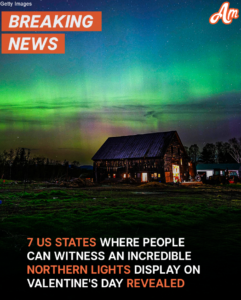The Northern Lights, or aurora borealis, are a captivating natural phenomenon resulting from charged particles from the sun interacting with Earth’s magnetic field. In the United States, the best opportunities to witness this spectacle are typically in northern regions, especially during periods of heightened solar activity.
Current Solar Activity and Aurora Visibility
As of February 14, 2025, we are approaching the solar maximum, a period of increased solar activity that enhances the frequency and intensity of auroral displays. This heightened activity is expected to last for several months, providing more opportunities to observe the Northern Lights.
Optimal Viewing Locations in the U.S.
On Valentine’s Day, the most promising locations to view the Northern Lights in the U.S. include:
-
Alaska: Particularly around Fairbanks, which lies under the auroral oval and often experiences vivid displays.
-
Northern Minnesota: Areas such as Duluth and Voyageurs National Park offer dark skies favorable for aurora viewing.
-
Northern Michigan: Regions near Lake Superior, like Marquette, provide good vantage points.
-
North Dakota and Montana: Cities like Fargo and Great Falls can occasionally witness auroral activity during strong solar events.
Weather Considerations
Clear, dark skies are essential for aurora viewing. As of February 14, 2025, the weather forecasts for these locations are as follows:
-
Fairbanks, Alaska: Mostly cloudy with temperatures around 10°F (-12°C).
-
Duluth, Minnesota: Cloudy with some afternoon snow, high of 17°F (-8°C).
-
Fargo, North Dakota: Snow and flurries expected, high of 13°F (-11°C).
-
Great Falls, Montana: Colder with snow and flurries, high of 4°F (-16°C).
-
Marquette, Michigan: Mostly cloudy and cold, high of 19°F (-7°C).
Given these conditions, areas with clearer skies, such as Marquette, Michigan, may offer better viewing opportunities.
Tips for Aurora Viewing
-
Check Aurora Forecasts: Regularly monitor aurora activity predictions from reliable sources like the Geophysical Institute’s Aurora Forecast.
-
Choose Dark Locations: Select areas away from city lights to minimize light pollution.
-
Stay Updated on Weather Conditions: Clear skies are crucial; keep an eye on local weather forecasts.
-
Be Patient and Prepared: Dress warmly, bring necessary supplies, and be ready to wait, as auroral activity can be unpredictable.
While witnessing the Northern Lights requires a combination of favorable solar activity and clear weather conditions, the approaching solar maximum increases the likelihood of experiencing this natural wonder. Planning ahead and staying informed will enhance your chances of a successful aurora sighting.
